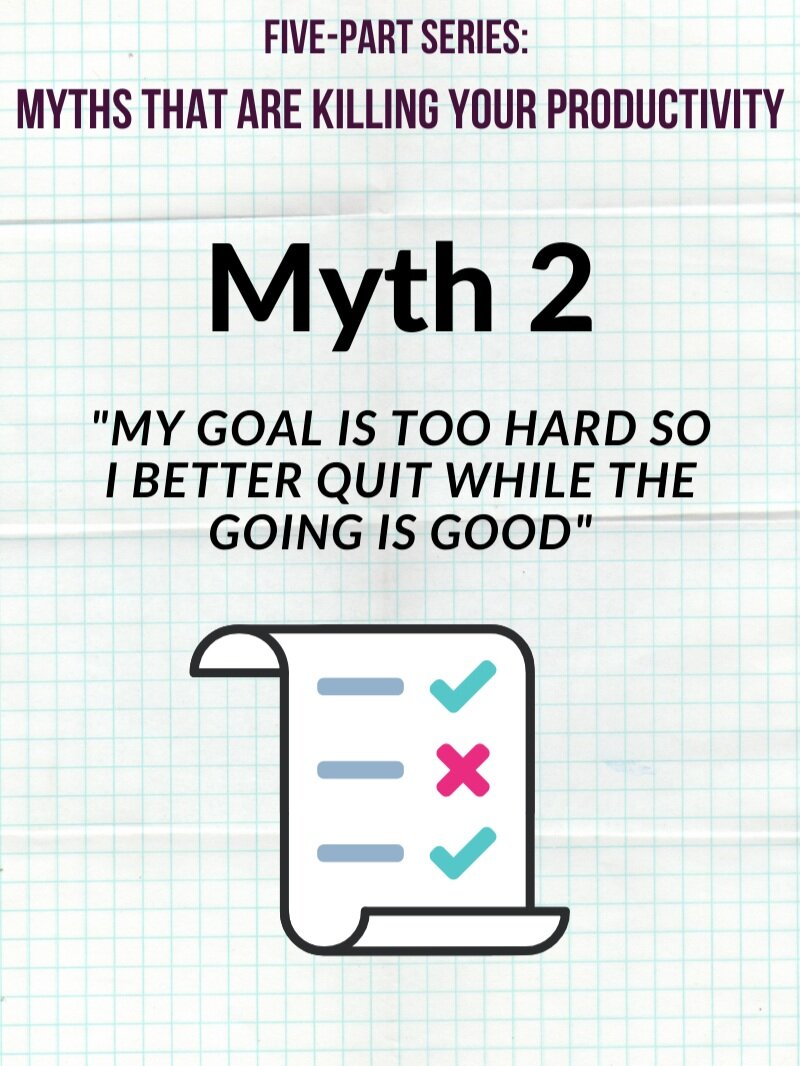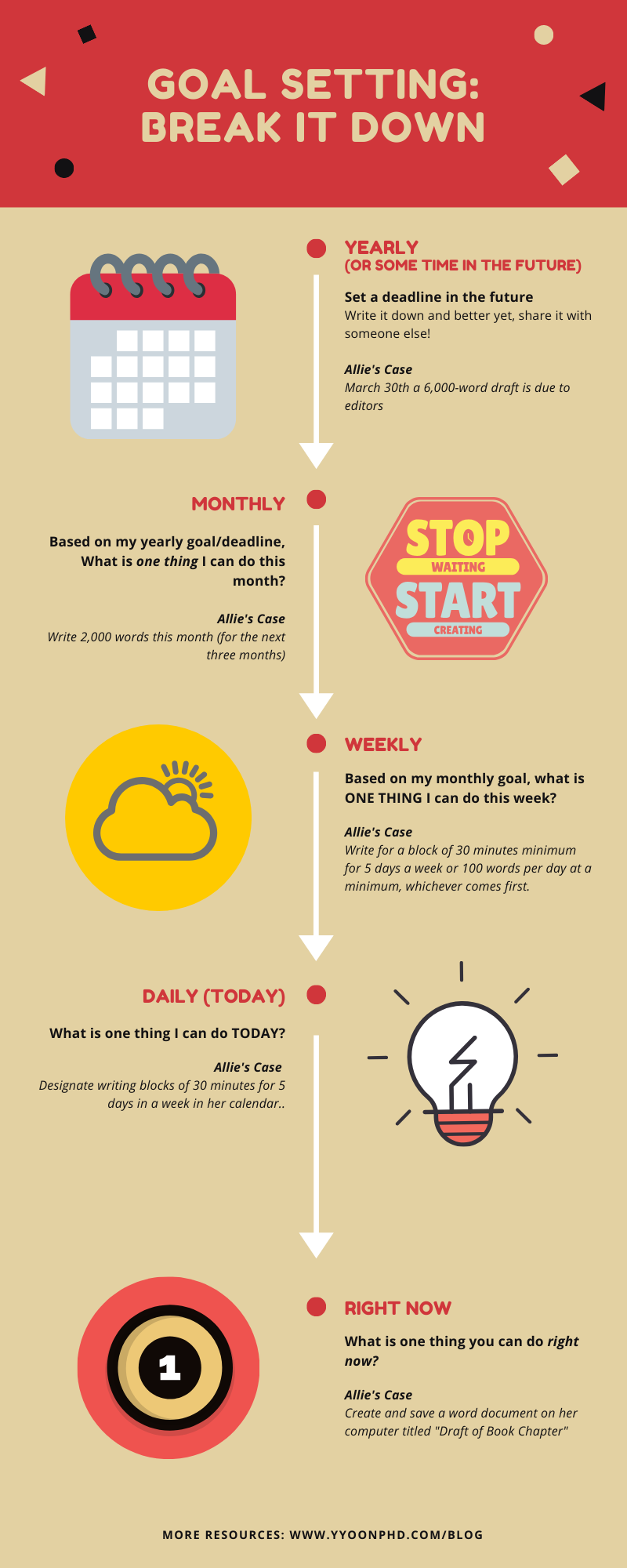Myth 2: My goal is too hard so I better quit while the going is good.
Truth: Your goal isn’t the problem. Your problem is the way you’re trying to accomplish your goal.
How many hours have you spent setting goals and making thorough to-do lists?
How much time have you spent putting down your goals in planners and downloading habit trackers and fancy productivity apps?
But have you found that it’s so much harder to stick to your plan and to stay consistent?
At the first sign of challenge or feeling overwhelmed, you may tell yourself that your goal is too hard, not important, dumb, impossible, or simply not worth the effort and stress, and you stop trying. When this happens, you most likely feel less motivated, disappointed, and start sabotaging your efforts.
If this experience resonates for you, take yourself off the hook and know that you are one of many many individuals who struggle with consistent action towards goals.
Do you want to feel a greater sense of accomplishment and satisfaction in reaching your important goals?
The truth is: Your process of reaching your goal is set up in a way that you are unintentionally sabotaging your chances of making progress.
Process = How you’re going about all the goals and new habits.
Process = The steps you are taking and not taking that may be screwing you up.
Today I’ll tell you how to adjust the way you set and tackle your goals so you can make real progress on your goals.
How to stop sabotaging your goal-setting efforts: Take the right first step
Taking the appropriate first step towards your goal is critical in determining your path to success.
An all-too-common mistake that we make when it comes to taking action towards a goal is that we go big. When we try to build a habit, our initial jolt of motivation can trick us into wanting to act big, act fast, and take on a larger portion than we can sustain in the long run. But instead, a series of the appropriate short term baby steps will yield long term gains toward results.
How do I know what is the best first step?
Break Down Your Goal and Work Backwards to Now
The key is to break down your goal into manageable and actionable steps.
Here’s how Allie stopped procrastinating once she broke down her goal into small actionable steps.
Meet Allie
Allie needed help meeting a deadline for a book chapter she was submitting to her editors. She put off writing a single word for months but she knew the deadline was fast approaching.
Me: What is your goal?
Allie: I want to have a complete draft of a book chapter submitted to my editors.
Me: What is your timeline for when you’d like to complete this goal?
Allie: By the end of March next year which is three months from now.
We settled on an exact date in March and she wrote this date down next to her goal.
Now let’s say Allie and I agreed: “Write a book chapter by March” was her goal and left it at that.
What do you think is likely to happen?
She will walk out of my office and each day that goes by, she is not going to know what concrete action step to take. More mental energy will be spent trying to figure that out instead of making progress on writing.
She’ll likely prefer doing anything else than figure out how to “write a chapter”. The task of “writing a chapter” will remain daunting as hell so she’ll be more likely to procrastinate and put it off.
The more time goes on that she’s not working on it because it’s “too hard”, the less motivated she’ll be and the harder it will be to get on track. She’ll come back to my office with her head down, sheepishly making some excuse as to why she couldn’t write.
Sound familiar? Have you experienced something like this before?
So how do we break down a goal into something more manageable?
Check out below how to break down a goal from the future all the down to the exact action step you can take right now. Look at how we did this with Allie.
Get that Momentum
Breaking down a goal into all its itty-bitty parts may seem a little tedious and like it’s “too small”. But the key is to keep the process manageable and to yield momentum.
Goal-setting and breaking it down is essential.
Be clear about what will get in the way of following through with each action step and nip that sh*t in the bud.
What is the number one thing that is most likely to get in the way of accomplishing this first step?
Create a plan to overcome the obstacle that will get in the way of achieving your one action step.
Distractions at work or at home are typically the number one culprits of sabotaging our efforts. How can you create a system so you are distraction-free? Perhaps implementing this is your one first baby step!
Q: How do I know if I have set the appropriate goal? Can the goal be the problem?
Yes, sometimes the problem is that your goal is impractical or is not something valuable and personally meaningful to you. In a future blog, I will write more in depth about how to know if you’re setting the right goal…Stay tuned. :)
Don’t forget to be your biggest cheerleader.
Be Your Own Cheerleader
Remember you can try again.
Keep going.
Part of being a cheerleader means being kind, patient, and compassionate with yourself. Treat yourself as you would a friend or loved one. If that person is trying something and you see them struggle, will you tell them “you suck, just give up”? (I hope not. If you do, let’s talk because...uh, no).
No, you will not. Instead you’re likely to say “Try again. You can do it.”
So do the same to yourself. Offer yourself that compassion.
Find someone to support you in this process
You also don’t need to feel like you have to do this alone. Changing behaviors, creating new habits, all this is hard work. You can call on someone else to help keep you accountable, think through strategies, or better yet to do the habit with you.
More on this to come in Part 5 of the Myths that are Killing Your Productivity Series...
Conclusion
You have the potential to create and more importantly maintain new habits. It is not out of the realm of possibility just because you’ve struggled to do so in the past. Let go of past mistakes and shortcomings. Don’t let that drag you down.
Act Small - Goal-setting is a series of setting and implementing small baby steps. Break down the goal into small actionable steps. Take each step in order (not all at once. No multitasking, remember?)
Minimize Potential Distractions: Find ways to stop the things that are likely to get in the way of your action steps.
Be Kind to Yourself: When you fail to follow through with an action step, be kind to yourself. Encourage yourself as you would a friend. Keep going.
Seek Support and Stay Accountable: You don’t need to face these tasks alone. Seek the power of accountability.
Sneak Peak of What’s to Come:
Myth 1 - Multitasking will get more things done faster
Myth 2 - My goal is too hard so I better quit while the going is good.
Myth 3 - Saying no is bad
Myth 4 - Self care can wait.
Myth 5 - I can do everything by myself
What is one goal you’d like to achieve?
Try this exercise of breaking down your goal and let me know in the comments what is the one action step you’re going to take today towards this goal?
Resources. Read more about “goal setting to the now”
The One Thing: The Surprisingly Simple Truth Behind Extraordinary Results by Gary Keller and Jay Papasan










